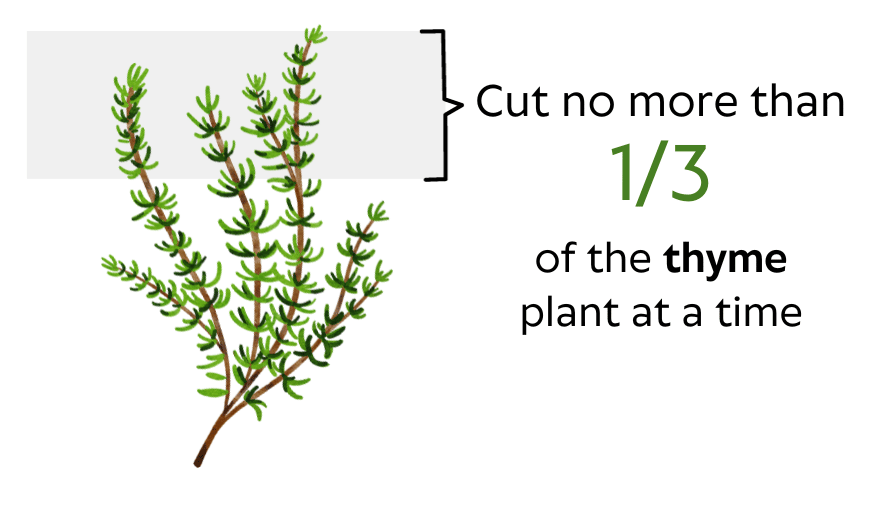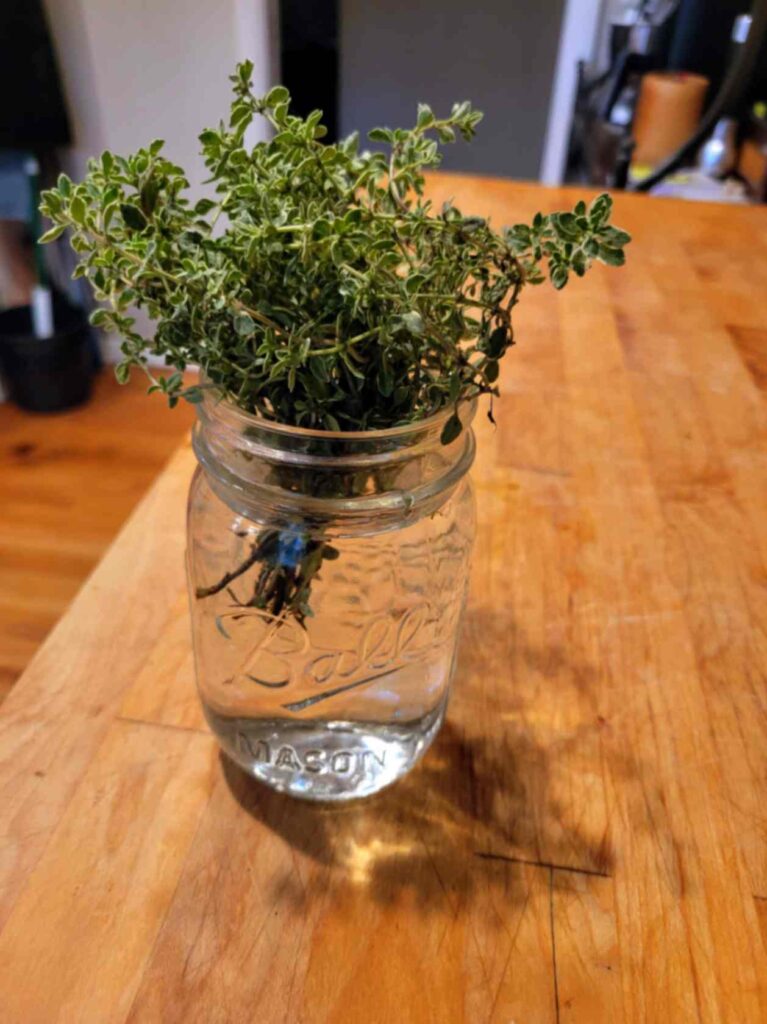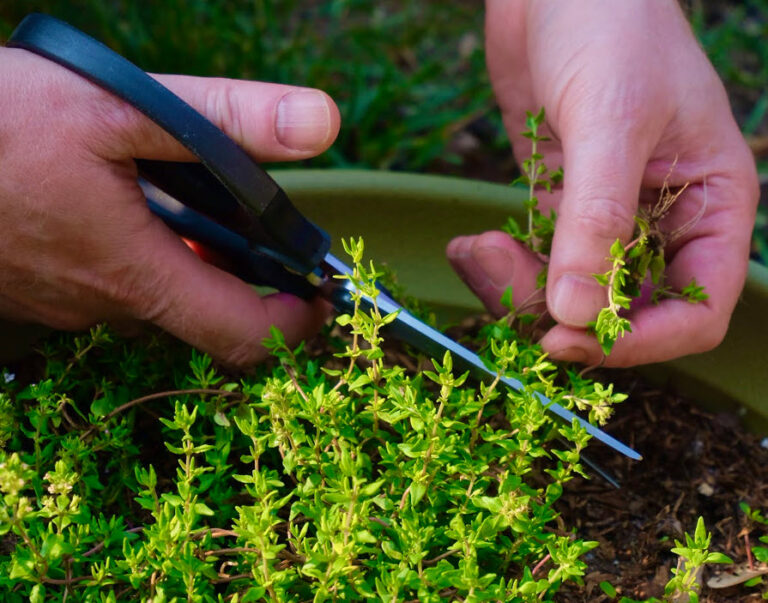This post may contain affiliate links which means I may receive a commission for purchases made through links. I only recommend products that I have personally used. As an Amazon Associate I earn from qualifying purchases. Learn more on my Private Policy page.

Whether you’re a seasoned gardener or just starting out, understanding the art of harvesting thyme is crucial to ensure optimal growth and flavor.
Table of Contents
Harvesting Thyme: Quantity and Timing
How much thyme should you harvest?
The quantity you gather depends on your needs. It’s essential to strike a balance between harvesting enough for your culinary adventures while ensuring the plant remains healthy and continues to thrive. Overharvesting can weaken the plant and hinder its ability to grow back vigorously.

When is the Best Time to Harvest Thyme?
Harvesting thyme at the right time is crucial to preserving its flavor and aroma. The optimal time of day for harvesting thyme is in the morning, just after the dew has dried but before the sun becomes too intense. This timing ensures that the essential oils responsible for thyme’s distinct flavor are at their peak concentration.
The ideal time to harvest thyme is just before it flowers. Thyme generally blooms in late spring or early summer, but it may flower later in the summer in cooler climates. At this stage, the herb has peak flavor due to higher essential oil concentrations responsible for its distinctive aroma and taste.
Why Timing Matters
- Flavor enhancement: Picking thyme before flowering maximizes taste and fragrance.
- Essential oil concentration: Morning harvesting peaks essential oil concentration.
- Freshness preservation: Picking before flowering maintains freshness as older leaves lose flavor.
Tips for an optimal thyme harvest
To make sure you get the most out of your thyme harvest, here are some additional pointers:
- Time of day: As mentioned earlier, the morning is an excellent time to harvest thyme. The essential oils are at their peak concentration, ensuring maximum flavor.
- Tools: Use a pair of clean and sharp pruning shears or scissors to harvest your thyme. This will minimize damage to the plant and allow for precise cuts.
- Harvesting technique: When harvesting thyme, focus on individual stems rather than plucking leaves one by one. Cut the stem just above a leaf node to encourage new growth from that point.
Remember, harvesting thyme is not a one-time event but an ongoing process throughout the growing season. By adopting a regular harvesting routine and paying attention to timing, you’ll enjoy abundant yields while ensuring the health and vitality of your plant.
Preserving Fresh Thyme
There are several simple methods you can use to keep your thyme fresh and flavorful. Here are some effective ways to preserve your harvest of thyme.
Storing Thyme in Airtight Containers or Damp Paper Towels
One popular method for preserving fresh thyme is by storing it in airtight containers or wrapping it in damp paper towels before placing it in the refrigerator. This helps maintain its freshness and prevents wilting.
- Gently wash the fresh thyme sprigs under cold water and pat them dry with a clean towel.
- If using an airtight container, place the sprigs inside, making sure they fit comfortably without overcrowding.
- Alternatively, if using damp paper towels, wet them slightly and wring out any excess water.
- Lay the sprigs on top of the damp paper towels and fold them over gently.
- Place the wrapped thyme sprigs in a plastic bag or sealable container before refrigerating.
By following these steps, you’ll be able to extend the shelf life of your fresh thyme by up to two weeks.
Using Water Bouquets
Another interesting way to preserve fresh thyme is by treating it like a bouquet of flowers. By placing the sprigs in water, you can keep them hydrated and maintain their flavor for longer periods.

- Trim off any excess leaves from the bottom part of the sprigs using garden shears.
- Fill a glass or jar with about an inch or two of water.
- Arrange the trimmed thyme sprigs in the jar, making sure the stems are submerged in water.
- Place the jar in a cool spot away from direct sunlight.
This method can keep your thyme fresh for up to one week, providing you with readily available herbs whenever needed.
Freezing Thyme Leaves or Whole Sprigs
If you have an abundance of fresh thyme and want to preserve it for an extended period, freezing is a great option. Freezing helps retain the essential oils and flavors of thyme.
- Wash the fresh thyme sprigs under cold water and pat them dry.
- Remove the tiny leaves from the stems using your fingers or a fork.
- Spread out the leaves on a baking sheet lined with parchment paper.
- Place the baking sheet in the freezer for about two hours until the leaves are frozen solid.
- Transfer the frozen thyme leaves into a resealable plastic bag or container before returning them to the freezer.
Alternatively, if you prefer to freeze whole sprigs, follow these steps instead:
- Wash and dry the fresh thyme sprigs as mentioned earlier.
- Arrange the sprigs evenly on a baking sheet lined with parchment paper, ensuring they are not overlapping to prevent them from freezing together.
- Place the baking sheet in the freezer for about two hours until the sprigs are completely frozen.
- Once frozen, transfer the sprigs into a resealable plastic bag or container, making sure to remove as much air as possible before sealing.
- Label the bag or container with the date of freezing. Thyme can last up to a year in the freezer, but it’s best to use it within six months for optimal flavor.
Whether you choose to freeze your thyme as individual leaves or whole sprigs, remember these tips to ensure the best results:
- Always use fresh thyme: Thyme that’s already wilting or browning won’t freeze as well and can result in a less flavorful addition to your meals.
- Freeze quickly: The quicker you freeze your thyme after harvesting the better. This helps to preserve the essential oils that give the herb its flavor.
- Use airtight containers or bags: Oxygen can degrade the flavor of frozen thyme, so it’s important to use airtight containers or bags when storing it in the freezer. Using vacuum pack bags is a great option for storage.
Freezing thyme is a fantastic way to ensure you have this aromatic herb at your disposal whenever you need it. By following these guidelines, you can enjoy the fresh taste of thyme all year round.
Drying Thyme for Long-Term Storage
Preserving the Flavorful Aroma of Thyme
Drying thyme is a traditional method that allows you to store this herb for an extended period without compromising its delightful aroma and taste. Whether you prefer air drying or using a food dehydrator, both herb drying methods are effective in removing moisture from the herb, ensuring it remains usable for months to come.
Air Drying: A Classic Approach
Air drying thyme is a simple yet effective way to preserve its flavor. Begin by gathering whole bunches of fresh thyme and tying them together with kitchen twine. Hang these bundles upside down in a well-aerated area away from direct sunlight. This allows the thyme to dry naturally while maintaining its aromatic oils.
During the drying process, it’s important to keep in mind that air circulation is crucial. Make sure there is enough space between each bundle to allow proper airflow. You can also place a paper bag over each bunch to catch any fallen leaves while still allowing air to circulate freely.
Patience is key when air drying thyme as it can take up to two weeks for the herbs to completely dry out. Once they are brittle and crumble easily between your fingers, they are ready for further preparation.

Using a Food Dehydrator: Quick and Convenient
If time is of the essence or you prefer a more efficient approach, using a food dehydrator can speed up the drying process without sacrificing quality. Set your dehydrator at low temperatures (around 95°F or 35°C) as higher heat levels may cause loss of flavor and essential oils.
To prepare the thyme for dehydration, spread the thyme evenly on the trays of your dehydrator. Make sure not to overcrowd them, as this can hinder proper drying. Leave the thyme in the dehydrator for approximately two to four hours, or until they are completely dry and crumbly.
Check out my article about how to dry woody herbs like oregano, thyme, sage, and rosemary for more tips and techniques for drying these kinds of hardy herbs.
Storing Dried Thyme: Keeping It Fresh
Once you have successfully dried your thyme, it’s important to store it properly to maintain its freshness and flavor over time. Follow these simple tips:
- Remove the leaves from the stems: Gently separate the dried leaves from their stems by running your fingers along the stem in the opposite direction of growth. This will ensure you only store the flavorful leaves.
- Choose suitable containers: Opt for airtight containers such as glass jars or resealable plastic bags that can effectively keep moisture out.
- Protect from heat and light: Store your dried thyme in a cool, dark place away from direct sunlight, as exposure to heat and light can cause loss of flavor and potency.
- Optional freezing method: For even longer storage periods, consider placing your dried thyme in a freezer bag or vacuum-sealed container before storing them in the freezer. This can extend their shelf life up to a year.
Other Methods of Preserving Thyme
Infusing thyme in oil or vinegar
Infusing thyme in oil or vinegar is a fantastic way to preserve its incredible flavor while creating versatile culinary ingredients. When you infuse thyme in oil, the aromatic oils from the herb blend with the oil, resulting in a richly flavored infusion that can be used for cooking or as a dressing. Simply gather fresh thyme sprigs and place them in a bottle with your chosen oil, such as olive or grapeseed oil. Let it sit for about two weeks to allow the flavors to meld together. The infused oil can then be used to drizzle over salads, roasted vegetables, or even grilled meats for an extra burst of thyme goodness.
Similarly, infusing thyme in vinegar is another delightful option. By combining fresh thyme sprigs with vinegar, you create a tangy and herbaceous infusion that adds depth to various dishes. To make this flavorful concoction, fill a jar with white wine vinegar and add fresh thyme sprigs. Seal the jar tightly and let it sit for at least two weeks to fully develop the flavors. This infused vinegar can be used in salad dressings, marinades, or even as a finishing touch on cooked dishes.
Making thyme-infused salt
If you’re looking to add a savory touch to your dishes while preserving thyme’s essence, making thyme-infused salt is an excellent choice. It’s simple yet incredibly effective at enhancing the flavor of your favorite recipes. Start by drying out fresh thyme leaves until they are brittle and crumble easily between your fingers. Once dried, mix the crushed leaves with sea salt in a ratio that suits your taste preferences—roughly one part dried thyme leaves to four parts sea salt works well as a starting point. This homemade herb-infused salt can then be sprinkled over roasted vegetables, grilled meats, or even used as a seasoning for popcorn.
Creating herb butter with chopped fresh thyme
Herb butter is a delightful way to enjoy the flavor of fresh thyme in various recipes. By combining chopped fresh thyme with softened butter, you create a versatile ingredient that can be used in both savory and sweet dishes. Start by finely chopping fresh thyme leaves and mixing them into softened butter until well combined. This herb-infused butter can then be spread on warm crusty bread, melted over grilled steaks, or even added to mashed potatoes for an extra burst of herby goodness.
Storing Thyme: Best Practices and Tips
Store dried thyme in a cool, dark place to maintain its potency for up to one year.
It’s essential to create the ideal environment that will preserve its flavor and potency. The first step is finding a cool and dark place where you can store your dried thyme. This could be a pantry shelf or a cupboard away from direct sunlight.
To ensure maximum freshness, transfer the dried thyme into an airtight container. Mason jars or glass containers with tight-fitting lids work well. Make sure the container is clean and dry before placing the dried thyme inside.
Label your storage containers with the date of harvest or drying to keep track of freshness.
To avoid confusion about when you harvested or dried your thyme, it’s crucial to label your storage containers properly. Using a marker or adhesive labels, write down the date of harvest or drying on each container. This way, you’ll always know how long your thyme has been stored and whether it’s still within its optimal freshness period.
If you have multiple containers with different batches of dried thyme, labeling becomes even more important. It helps you identify which batch is fresher and decide which one to use first.
Avoid storing fresh thyme near ethylene-producing fruits as it can accelerate spoilage.
Fresh thyme requires slightly different storage conditions compared to its dried counterpart. While both need cool environments, fresh thyme should be kept away from ethylene-producing fruits like apples, bananas, and tomatoes. Ethylene is a natural ripening agent released by these fruits that can cause fresh herbs like thyme to spoil faster.
To prevent premature spoilage, store fresh thyme in a separate compartment in your refrigerator. Consider using resealable bags or wrapping it loosely in paper towels before placing it in the fridge. These measures help maintain its freshness and prevent cross-contamination with other foods.
Regularly check stored thyme for any signs of mold or deterioration and discard if necessary.
Even with proper storage, it’s essential to regularly inspect your stored thyme for any signs of mold or deterioration. Over time, moisture or improper handling can lead to the growth of mold, which renders the thyme unusable.
To check for mold or deterioration, examine the dried thyme closely. Look for discoloration, unusual odors, or clumping that may indicate spoilage. If you notice any of these signs, it’s best to discard the affected batch to avoid potential health risks.
Conclusion
Harvesting thyme requires careful consideration of quantity and timing. It is important to harvest the herb at the right stage of growth to ensure optimal flavor and aroma. Preserving fresh thyme can be done through various methods such as freezing or using it in oil or vinegar infusions.
For long-term storage, drying thyme is a popular choice. This method allows you to enjoy the herb’s benefits even when it’s out of season. However, there are alternative ways to preserve thyme, including making herb butter or creating herb-infused salts.
When storing thyme, it is essential to follow best practices and tips. Keep the herb in a cool, dry place away from direct sunlight to maintain its quality for longer periods. Properly stored thyme can last many months without losing its potency.
To make the most out of your harvested thyme, consider incorporating it into your everyday cooking. Whether you use it in soups, stews, marinades, or teas, this versatile herb adds a delightful flavor profile to various dishes.
Remember that freshness plays a crucial role in enhancing the taste and fragrance of thyme. So don’t hesitate to experiment with different preservation methods until you find what works best for you.
Now that you have learned about harvesting and preserving thyme effectively, put your knowledge into practice! Start growing your own supply of fresh herbs and enjoy the satisfaction of adding homegrown flavors to your culinary creations.
Frequently Asked Questions (FAQs)
How do I know when my thyme is ready for harvest?
Thyme is ready for harvest when it reaches full maturity and starts producing flowers. The ideal time is usually before flowering begins but after the plant has developed enough foliage for sustainable growth.
Can I freeze fresh thyme?
Yes, freezing fresh thyme is an excellent way to preserve its flavor for an extended period. Simply wash and pat dry the sprigs, remove the leaves from the stems, and store them in an airtight container or freezer bag.
Can I dry thyme without using any special equipment?
Absolutely! Air drying is a simple method that requires no special equipment. Bundle the thyme sprigs together and hang them upside down in a well-ventilated area until they are completely dry.
How long does dried thyme last?
When stored properly in an airtight container away from heat and moisture, dried thyme can retain its quality for up to one year.
Are there any other creative ways to use preserved thyme?
Certainly! Preserved thyme can be used to infuse oils, vinegar, or even honey. It adds a unique flavor twist to homemade salad dressings, marinades, and infused beverages like herbal teas.
Is it possible to regrow thyme from cuttings?
Yes, propagating thyme from cuttings is relatively easy. Simply take stem cuttings from an established plant, remove the lower leaves, dip the cut end into rooting hormone (optional), and plant it in moist soil or water until roots develop.
Does harvesting thyme promote new growth?
Harvesting thyme correctly actually encourages new growth by stimulating lateral branching on the plant. Regular pruning helps keep the herb bushy and productive throughout the growing season.
Can I use harvested thyme immediately after washing it?
It’s generally best to avoid using wet herbs directly after washing them as excess moisture can dilute flavors when cooked or consumed raw. Allow the thyme to air dry or gently pat it dry before use.
Last Updated on 9 January 2024 by Bob Lee

